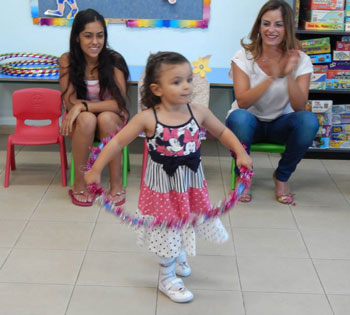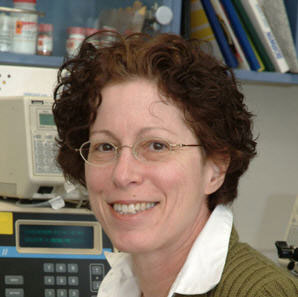Hadassah
Feature
Health + Medicine
Feature
Gene Trackers

Tohar was 6 months old when she picked up her first feverish cold. It cleared within days—to be replaced by something far graver. The child began losing movement in her legs until they were totally paralyzed. No doctor knew why.
Worse was to come: Months later, when children her age were taking their first steps, she got another cold. As before, it passed quickly but, as it did, her arms stopped moving, too.
“I’m reliving a nightmare,” her mother told Dr. Orly Elpeleg, head of the genetics department at the Hadassah–Hebrew University Medical Center in Jerusalem. “All she can move are her fingers and head. This is what happened to our son. He died when he was 4.”
Tohar’s illness was unknown to medicine. It had no name, no treatment and no known cause or prognosis. It is for tracking down the faulty genes responsible for rare disorders like these, and thus helping prevent or treat the havoc they wreak, that Dr. Elpeleg was named the 2013 recipient of the Samuel and Paula Elkeles Outstanding Scientist in Medicine Prize. Among Israel’s premier scientific honors, its 26 laureates include biologist Aaron Ciechanover, who went on to receive a Nobel Prize.
With 29 new disease-associated genes identified and a similar number in the pipeline, Dr. Elpeleg’s team is one of the world’s foremost in tracking faulty genes. “I hate not knowing,” she says. “When we are closing in on a culprit gene, we will work nights and weekends to get it!”
For families like Tohar’s, there would have been no answers as little as three years ago—no prognosis or way of knowing whether future children would also live short, paralyzed lives. Accepting the Elkeles award in Jerusalem last November, Dr. Elpeleg looked back to where it began for her: her residency in pediatrics over 30 years ago.

“At that time, pediatric textbooks had three sections,” she recalls. “One featured infectious diseases, which were largely curable. The second was about cancers, many now also curable. The third and longest was called ‘Miscellaneous’: It described severely dysfunctional children with mental retardation, seizures, insufficiencies of the heart, lungs and liver, or collapse following normal development. Although it speculated that many diseases were genetic, they got scant attention because there was little to be done for these unfortunate children.”
It was the celebrated pediatric neurologist Dr. Naomi Amir who pointed Dr. Elpeleg toward these “miscellaneous” disorders. “Probing them could be a lifelong task for you, of very great value,” Dr. Amir presciently told her young resident.
“As it turned out, I not only had a brilliant mentor in Naomi Amir, but I was also in the best possible place,” recalls Dr. Elpeleg. “I was in Jerusalem, where the patients are.”
When she started out in the field she has done much to build, the tools had yet to be invented. “Some 85 percent of disease-causing mutations are harbored in the 30 million letters of coding DNA known as the exome,” Dr. Elpeleg says. “In the early 1990s, this took months to read, so we had to guess which fragments contained the mutation and examine only those. It was like looking at the Atlantic and guessing where to reach in to pull out one faulty fish.”
The Hadassah team was one of very few in those years that repeatedly guessed right about where to find the sick fish. “Our great advantage was the very many consanguineous families on our doorstep,” explains Dr. Elpeleg, who was recruited to Hadassah by then-Director-General Dr. Shlomo Mor-Yosef in 2005. “In many of Jerusalem’s sects, marriage between first cousins is traditional. This allowed us to narrow the search area to relatively small fragments of DNA.”
A mutation in a grandfather, she says, passes harmlessly and unnoticed to some of his children. They, in turn, unsuspectingly pass it to their children, so that the mutation is now carried by several members of the third generation. Should any of these carrier-cousins marry one another, there is a one-in-four chance of their children receiving the mutation from both parents and thus being born ill.
“These are mutations transmitted down a mere handful of families to produce children with illnesses that aren’t in any textbook,” says Dr. Elpeleg. “We were coming up with a new gene or two every year—100- to 200-percent more than any other research center anywhere.”
Even as the technology caught up—the Human Genome Project spinning off DNA-sequencers that read the entire exome within hours—Dr. Elpeleg’s team remains among the world’s most successful gene hunters. In 2013, they published 11 peer-reviewed papers describing new genes found in disorders in patients, compared with one or at most two published by other leading centers worldwide.
The reason, says Dr. Elpeleg, in addition to their (sadly) plentiful patients and stubborn tenacity, is the fact that her team is part of the Hadassah Medical Center. “There are no soloists,” she says. “We are good because Hadassah is fully committed to finding damaged genes in patients. Neurologists, immunologists, cardiologists, pediatricians—they are physicians with vast experience who have read the books and even written some of them, who have seen thousands of patients and can reliably say: ‘There is a genetic factor here.’ Or, ‘I have not seen this before. This is new.’”
It was pediatrics division head Dr. Eitan Kerem, together with Drs. David Shoseyov and Malena Cohen, whose observation triggered the discovery of one of the 11 mutated genes published in 2013—the LRRC6 gene. “We were treating five children from two families for the repeated lung infections, sinusitis and ear infections that are typical of PCD [primary ciliary dyskinesia],” Dr. Kerem says. “In three of these youngsters, their internal organs were transposed—that is, the heart and liver were on the right, and the stomach and spleen on the left.”
An inherited illness that occurs in at least one of 15,000 births, PCD compromises the functioning of the tiny protective hairs, or cilia, that coat every cell in the respiratory airways. “The cilia are composed of proteins manufactured by many different genes,” explains Dr. Kerem. “The gene we found is not only one of 15 responsible for the cilia’s composition, it also supervises their construction. Cell cultures from our five patients showed a much-reduced expression in LRRC6. This caused irregular cilia that function poorly.”
Knowing more about cilia is important not only for diagnosing PCD patients more quickly and so preventing or delaying permanent lung damage. Cilia also coat cells in the male and female reproductive systems, where their malfunction can cause infertility; and, as the transposed organs of some PCD sufferers show, they also play a key role in fetal development.
While PCD is fairly rare, it does appear in textbooks. Its victims and their families join in support and advocacy groups and on websites, and it attracts some high-level research. In illnesses endured by children like Tohar, however, there are too few patients for any of this.
“Diagnosing obscure disorders like these can take years,” says Dr. Elpeleg. “This hugely increases the already heavy burden on parents. Should they look for different doctors? What if there is something to be done, but they cannot find out what it is in time? Will their healthy children marry, with undiagnosed illness in the family? A diagnosis, even when there is no cure, puts families in a totally different place. They have a name for the illness, can contact others who live with it and remove its stigma from their healthy children.”
Tohar had seen many doctors before her parents brought her to Dr. Elpeleg in the spring of 2012. “The child’s medical history—fever and cold, followed by deterioration—suggested this was an immunological issue,” Dr. Elpeleg says. She brought in Dr. Dror Mevorach, head of Hadassah’s Department of Medicine and an immunology specialist.
Collaborating with physicians countrywide, the team found three other families carrying the same illness and embarked on the thorough reading of their DNA. Within days, they had found a variant DNA common to them all—a variant that caused not different eye color but paralysis. It was located on gene CD59, where a protein that blocks the immunologic reaction to flu-like viruses is encoded.
“A mutation here had crippled the protein’s off-switch,” says Dr. Mevorach. “Instead of subsiding once it dispatched the virus, it sought further prey—and found it in the myelin sheath that protects the peripheral nerves [outside the brain and spinal cord]. It attacked the myelin, eventually destroying the nerves beneath. At last we had a diagnosis.”
Treatment was the next question. It was Dr. Mevorach who came up with a way to block the faulty CD59 activity—an existing FDA-approved medication that turns off the protein at the right time. Infused twice a month for life, its main problem is its cost—over $10,000 a month per child. “We found a generous donor, and began treating these children in summer 2012,” he says.
“The families no longer lived in terror of their children picking up another cold and could mix freely with others,” says Dr. Elpeleg. “And, with the gene identified, healthy and future siblings of these paralyzed children could be screened for the mutation. This is what tracking down the gene gave these families.”
As things turned out, however, it gave the families far more than this.
In the months that followed, something completely unexpected happened. Despite the crippling damage to the children’s nerves, the paralysis began to reverse.
Slowly, movement returned to paralyzed limbs. The children began to stagger and then to walk. Now over 4, the age at which her brother died, Tohar attends dance classes, twirling steadily and happily, indistinguishable from all the other little girls.










 Facebook
Facebook Instagram
Instagram Twitter
Twitter
Leave a Reply